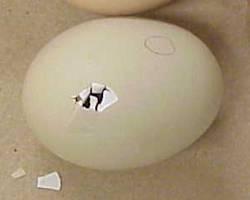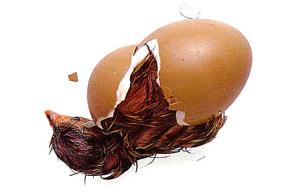Hatching and stress associated with it
Unlike the often very sudden birth in mammals, hatching in bird may take several days.
1-2 days before hatching the chick fetus pokes through the air cell. We now say that the egg is internally pipped or IP. This is very critical time for the chick and takes its first breath. Before internal pipping all the gas exchange takes place in the chorioallantic membrane CAM . This is a thin membrane located under the shell filled with blood vessels which takes up enough oxygen to support the entire fetus. A couple of day before hatching this membrane can not provide the fast growing chick fetus with oxygen and for the first time ever the chick is in need of it’s lungs. At the point of internal pipping the chick fetus goes from being water living to air breathing in a matter of seconds.
The next step towards hatching is when the chick manages to penetrate the egg shell this can be done up to a day before what we call hatching takes place. At this point the chick is fully independent of the CAM and all gas exchange is managed by the rapidly increasing lung capacity. After the chick has penetrated the egg shell we say that the egg is externally pipped or EP. Now the chick can for the first time breath air from outside the eggshell and is now for the first time independent of the limitations of the egg shell. The chick has now conquered two of the most critical steps of being born but is still far from done.
For the chick to have enough strength left to break free from it’s out grown compartment which it have spend its life up to this point all other prior stages of development and hatching must have been advantageous enough or else the chick will not have the strength it needs left and will not make it.
During all natural incubation, the incubating parent must find a working balance between their own need to forage for food with the thermal need of the embryos. Several studies dealing with the effects of ambient temperatures on avian incubation suggest three important thresholds: physiological zero (26.0◦C, where development stops), lower limit of optimal development (36.0◦C, where the paste of development decreases) and upper lethal (40.5◦C, all higher temperatures can kill the fetus). The cost of incubation is high for the incubating parent and a correct incubation temperature is crucial for successful embryonic development. Consequently, any way for the fetus to communicate its well-being would be beneficial for both the fetus and the incubating parent.
Responsible for this page:
Director of undergraduate studies Biology
Last updated:
05/02/06


